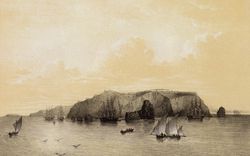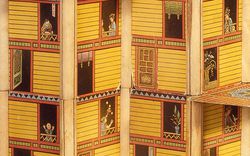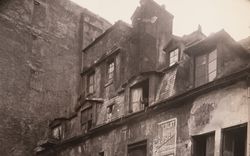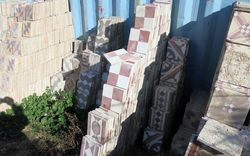Inexhaustible Terrain
Text by Jane Hutton
Approaching from the coast of Pisco, Peru, the Chincha Islands appear like three giant barnacles latched onto the horizon. The islands, each about one and a half kilometres wide, are part of a guano-coated archipelago that runs along the country’s coast. Jhuneor Paitan Ñahui, a specialist in the Guano Islands and Capes National Reserve (Reserva Nacional Sistema de Islas Islotes y Punta Guaneras1) at SERNANP, Peru’s protected areas environmental agency, has agreed to take me to visit the islands and we speed westward by boat. Before my trip, I had seen a striking lithograph from 1865 showing a nearly similar vantage point with a vastly different view—three towering mountains, steeply battered in profile, surrounded by a gang of ships jockeying for a position close to the docks.
-
“Sistema de Islas, Islotes y Puntas Guaneras,” accessed 20 June 2015, http://www.sernanp.gob.pe/sistema-de-islas-islotes-y-puntas-guaneras. ↩
At the height of the Peruvian guano trade from the beginning of the 1840s through to the end of the 1870s, millions of seabirds, thousands of Chinese slaves, and scores of ships bound for New York City, Baltimore, and other American and European ports swarmed the three islands. The “mountains” were composed of guano, desiccated seabird excrement, whose introduction supported the industrialization of agriculture and transformed global metabolic paradigms in the late nineteenth century. Today, just one man occupies each island. Jorge Tarazona Paredes lives on Isla Chincha Norte, the northernmost, where he monitors the bird populations, hosts scientific researchers, guards against unauthorized fishing and poaching, and waits out the years before the next round of selective guano harvesting.
Read more
As we scramble up to the dock suspended over turbulent waters, using a slippery, four-and-a half-metre-long rope ladder, birds periodically storm overhead and land on different surfaces in the distance. Three species, the guanay cormorant (Phalacrocorax bougainvilli), Peruvian booby (Sula variegata) and Peruvian brown pelican (Pelecanus occidentalis thagus), are responsible for the majority of the guano mass, but many others move between islands throughout the day, fishing, preening, nesting. Speckled black hillsides reveal themselves to instead be white, as flocks of guanay take off. Cacophonous terrestrial life communicates an intensely productive and diverse sea-life. Positioned within the powerful Humboldt Current, which carries cold water up the coast of South America, the islands are immersed in an underwater tumult of debris. Phytoplankton and other microorganisms thrive in that environment and are a banquet for small fish.1 Nutrient rich anchovies or anchovetas (Engraulis ringens) are the primary food for the seabirds that, in turn, produce guano with a high nitrogen and phosphorus content.
-
J. Jahncke, D. M. Checkley, and Jr. G. L. Hunt, Jr., “Trends in carbon flux to seabirds in the Peruvian upwelling system: effects of wind and fisheries on population regulation,” Fisheries Oceanography 13, no. 3 (2004): 208–223. ↩
The island is a super-active volume. Porphyritic granite bedrock forms a stable plateau thirty metres above the sea, but the mass that lies on top of it continually changes. Like a glacial mass upon bedrock, the guano cap forms in response to, but independently from, its substrate. The birds and sea lions that bask on its beaches, nest on its peaks and inside caves, and dive for fish at its margins, literally become the island. Carcasses, eggs, bones, and sea lion teeth, cemented in layer upon layer of bird shit, transform from a conglomerate of biotic materials into homogenous sedimentary matter. Over time, the weight of accumulating guano compacts and concentrates the material to a hard-packed mass. Wind carves the mass over time, hewing an aerodynamic profile. For most other guano islands, rain would erode the deposits but, remarkably, there is little to no rain off of coastal central Peru. Because of this unique biological and climatological convergence, guano accumulated over time but did not recede. Ecologist G. Evelyn Hutchison estimated that the accumulation found in the mid-nineteenth century was roughly fifteen hundred years old.1
Almost instantaneously, a landscape formed by unique conditions and exquisite ecological processes transformed into a lucrative material stockpile, abstracted and reduced to salable units. For centuries, Peru’s indigenous farmers harvested guano and applied it to crops, but it was the American and European appetite for guano’s unprecedented potency as an agricultural fertilizer that initiated the world’s “guano fever.” Deposited over millennia,2 the guano of Chincha Islands was depleted within decades. Over the four decades following 1840, ten million tons of guano, valued at half a billion dollars, were extracted and shipped away towards American and European ports.3
The voracious extraction of the guano on the Chincha Islands signaled fundamental shifts in the ways that nutrients were cycled through the soil and around the world—all enmeshed with processes of urbanization. As urban regions expanded, peripheral farms transitioned from self-sustaining to industrial models. Whereas soil fertility had always been achieved through the local cycling of manures produced on the farm, farmers began to substitute more processed, imported, and mined fertilizers. Guano was the gateway drug for farmers transitioning into industrialized agriculture. It was an easily transportable, quick-acting, and highly concentrated source of nutrients. Though a mined, mineral product, it was technically a manure.4 With the global trade of guano, nutrient cycles expanded from the scale of the farm to the urban region to the planet.
-
George Evelyn Hutchinson, “The biogeochemistry of vertebrate excretion,” Bulletin of the American Museum of Natural History 96 (1950): 70. ↩
-
Ibid. ↩
-
Richard A. Wines, Fertilizer in America: From Waste Recycling to Resource Exploitation (Philadelphia: Temple University Press, 1985), 45. ↩
-
Ibid., 37. ↩
Of the three hundred thousand tons of guano exported annually from Peru in the 1860s, forty thousand of those landed in New York City for use in the region.1 First adopted by British farmers, guano found a commercial market in the New York region by the 1840s, but widespread use took off in the 1860s as recycled manures failed to keep pace with modern farming. In the heart of New York’s expanding urbanizing and agricultural complex, Central Park was conceived as a pastoral proxy for New Yorkers deprived of access to the country. Central Park not only mimicked an agricultural landscape in form, but also—through the fertilizers applied to amend its soils and produce meticulous meadow grasses—reflected global shifts in metabolic flows. Frederick Law Olmsted and Calvert Vaux believed that the success of the park relied on the success of its expansive meadows and their pastoral effect. Olmsted experimented with a range of soil amendments being used by farms at the expanding periphery of New York City:2 horse manure from street sweepings, “night soil” from Manhattan’s privies, other processed fertilizers, and seabird guano from Peru and the South Pacific. Of the fertilizers applied to Central Park’s soil, guano was the most potent, exotic, and novel.
While used in relatively small increments, guano was emblematic of Olmsted’s interest in modern farming, and also of contemporaneous debates about the future of nutrient cycling. Some, like the Park’s agricultural engineer George E. Waring, advocated for the cycling of human and other local wastes, while many saw new manufactured and mined fertilizers as the way of the future. When Olmsted specified guano for Central Park, he did so from experience and professional curiosity, having been impressed with the widespread and successful use of guano seen during his travels. He enthused about guano’s proven powers in crop yields, yet cautioned against its injudicious use. Guano, in his opinion, was an additive of great value, but “real wealth” could only come from a longer-term consideration of soil health.
-
“Interesting to Farmers: Guano Its History, Traffic, Uses, Abuses, and Frauds Price of Peruvian Guano,” New-York Daily Tribune, 29 September 1860, 8. ↩
-
While Olmsted and Vaux both designed Central Park, Olmsted oversaw matters mostly related to the growth of plants. For further reading on the use of guano in Central Park, see Jane Hutton, “On Fertility: Night Soil, Street Sweepings, and Guano in Central Park,” Journal of Architectural Education 68 DESIGN+ (1 March 2014). ↩
In the same year that he was instructing the improvement of the soil for Central Park, Olmsted published his book Journey in the Seaboard Slave States: With Remarks on Their Economy.1 As a budding farmer, his journalistic lens was equally focused on agricultural techniques as on the conditions of slavery. Generations of intensive tobacco and cash-crop farming had left soils throughout the American South depleted and exhausted. In the years leading up to the Civil War, poor agricultural production threatened the South’s economic capacity for secession and control over the right to keep slaves. In an economy based largely on the violent exploitation of people, the spectre of abolition imperilled the farmers’ future. Guano’s arrival in the port of Baltimore in the 1830s coincided with Southern farmers’ growing desperation.2
The Southern farmers shared with Olmsted the belief that, in addition to their trials with exhausted soil, they suffered the lethargy and low energy of their slaves. The will of slaves to hold back some strength, Olmsted’s informants argued, exacerbated their depleted soils, poor crop yields, and overall economic instability.3 Furthermore, the slaves’ “indolence” worked against the civilizing values of cultivation. Slavery was a righteous force preventing this obliteration of the soil’s potential. One of his sources, the Hon. Willoughby Newton, believed that without guano the land would be fast deserted. Like slavery, guano could civilize the land; without it, it would return to wilderness.
In the eyes of slaveholders, guano and slaves were comparable and, to some degree, interchangeable. Both added value to the fields, though guano’s “strength” was unprecedented, and the slaves might soon become obsolete. The editor of the periodical Southern Cultivator opined in 1853: “Farmers should use more guano . . . instead of investing their money in more Negroes.”4 After the Civil War, realizing the costs of paying for labour, farmers began to lean on guano where human labour couldn’t be afforded.
As the Atlantic slave trade neared abolition in the United States, others took its place. American abolition threatened the supply of cheap cotton that had been flowing from the American South, and so capitalists went searching for other locations around the world, including Brazil and Peru, where they could establish lucrative plantations, often with forced labour.5 In the years leading up to American abolition, the media took note of these global labour dynamics. The abolitionist Frederick Douglass’ Paper reported in 1855 that “a new slave trade is going up in the world.”6 “The revelation is frightful,” the article stated, detailing the cruel treatment of Chinese workers in the Peruvian Chincha Islands, under British and Peruvian auspices.
On the Chincha Islands, as guano increased in value, the mountain was taken down. Indebted to Britain for aid in securing Peru’s independence, Lima granted a British company control over the Peruvian guano export market starting in the 1840s. While profitable for select members of the Peruvian aristocracy, most of Peru’s guano profits were siphoned from the country to pay the imperial debt to Britain.7 Relatively inert as a solid material, guano pulverizes as it is picked at for harvesting, releasing a caustic cloud with each stroke. Airborne guano assaults lungs, eyes, and mouths. Workers shoveled loosened guano into woven bags or directly into wheelbarrows, and wheeled them to nearby docks. Loads were tipped down mangueras chutes made of cane at the cliff edges, sliding directly into boat holds or otherwise carted in bags to launches. When big loads of guano were slid directly into the ship’s cavity, a cloud enveloped the boat.8
-
Frederick Law Olmsted, A Journey in the Seaboard Slave States: With Remarks on Their Economy (New York: Dix & Edwards, 1856). ↩
-
Pete Lesher, “A Load of Guano: Baltimore and the Fertilizer Trade in the Nineteenth Century,” The Northern Mariner/Le marin du nord 18, no. 3/4 (July 2008): 121. ↩
-
Olmsted, 91. ↩
-
Rosser H. Taylor, “Fertilizers and Farming in the Southeast, 1840–1950: Part I: 1840–1900,” The North Carolina Historical Review 30, no. 3 (July 1953): 310. ↩
-
Gregory T. Cushman, Guano and the Opening of the Pacific World: A Global Ecological History (reprinted Cambridge, New York: Cambridge University Press, 2014), 85. ↩
-
“New Slave Trade Frightful Revelation,” Frederick Douglass’ Paper, 14 December 1855, 3. ↩
-
Brett Clark and John Bellamy Foster, “Ecological Imperialism and the Global Metabolic Rift: Unequal Exchange and the Guano/Nitrates Trade,” International Journal of Comparative Sociology (Sage Publications, Ltd.) 50, no. 3/4 (June 2009): 319, 321. ↩
-
George Washington Peck, Melbourne, and the Chincha Islands: With Sketches of Lima, and a Voyage Round the World (New York: Scribner, 1854): 209, 211. ↩
A willing labour force for guano harvesting was not easily found. Having legally abolished slavery in 1854, Peru found itself without a captive labour force to do the gruelling work. Britain had abolished slavery in 1833, yet had a great stake in the profits of guano sales. To replace their newly emancipated workforce, Peru and Britain participated in a new form of slavery through the confinement of Chinese workers hired under false contracts of “free labour.” Men—derogatively known as coolies—left Hong Kong and Macau as free workers (although some were kidnapped) and arrived at the Chincha Islands as slaves. From the mid 1840s to 1870s, an estimated one hundred thousand men were taken from Chinese ports and sent to Peru’s plantations, railroad sites, and guano islands—the latter arguably the cruellest destination.1 The Trata Amarilla, or “yellow trade,” was the direct outcome of expanding capital markets newly facing the conundrum of the end of slavery. Such debt peonage lubricated by the growth of transportation systems, mining technology, and global demand for agricultural and industrial minerals, supplanted slavery in order to fuel global material exploitation.2 Betrayed and relocated to isolated locations like the Chincha Islands, labourers were unable to quit once the horrendous conditions were revealed.3 Companies could wield power otherwise illegal in a post-slavery context. Ships assumed the same violent organization of slave ships; workers were held captive below the deck and treated cruelly. One in ten captives was said to die on the five-month journey.4 Those who survived were, upon arrival in South American port cities, sold in slave markets, relatively unchanged from the slave era. This new form of “disguised slavery,” as Karl Marx had called such systems, was integral to what Clark and Foster identify as the mid-nineteenth century’s “triangle trade” of ecological imperialism: capitalist production robbed British and American soils, huge quantities of guano from Peru were extracted to “fix” them, and workers from China were “robbed” by their subjugation in the harvest.5
For the Chincha Islands, urbanization and the industrialization of agriculture in places as distant as New York City triggered a global demand for guano and initiated an industry characterized by unrestrained exploitation. In a world of expanding agriculture, which necessitated the repair of weak soils and the pursuit of higher yields, guano was a panacea. Capitalists, guided by the logic of “growth,” viewed the islands as an inert stockpile both of potential accumulation and of a material that would support agricultural fertility for the greater good. Through extraction and transport, the capitalists were the agents of nutrient cycles that connected guano to their depleted soils. The decimation of the Chincha Islands’ guano landscape, its bird populations, and the free lives of its labour force were the unseen consequences of agriculture’s modernization and the urban regions it supported.
Jane Hutton presented her research on guano at the CCA in June 2016 during the “Toolkit for Today: Keywords for the Environment” seminar, organized as part of the CCA Doctoral Students Program. This text is an excerpt from a forthcoming book, Reciprocal Landscapes: Cases in Material Movements (Routledge, 2017), which traces five materials used in emblematic New York City landscapes over the past 150 years and the reciprocity between their sites of origin and construction.
















